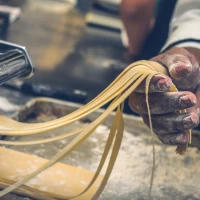Raw honey is a natural wonder that has been treasured by humans for centuries. This golden elixir, produced by bees from the nectar of flowers, not only adds a touch of sweetness to our meals but also offers a myriad of health benefits. In this article, we will take a deep dive into the world of raw honey, exploring its production process, nutritional profile, and the reasons why it should be a staple in your pantry. Whether you are passionate about organic foods or simply seeking to enhance your well-being, the journey from beehive to table will introduce you to the pure bliss of raw honey.
What Makes Raw Honey Different?
Processing Methods: Raw vs. Commercial Honey
The first distinction to understand when it comes to honey is the difference between raw honey and commercial honey. Raw honey is pure, unfiltered, and unprocessed, straight from the beehive to your table. It undergoes minimal processing, retaining all the natural enzymes, pollen, and propolis.
On the other hand, commercial honey often goes through an intensive filtration and pasteurization process. While this may increase its shelf life and clarity, it also strips the honey of its natural goodness beauty and the beast manga download. Commercial honey is heated to high temperatures, which can destroy beneficial enzymes and reduce its nutritional value.
Nutritional Profile of Raw Honey
Raw honey is not only a delectable sweetener but also a nutrient-rich food. It contains an array of vitamins, minerals, and antioxidants that can contribute to better health. Here are some key components found in raw honey:
-
Antioxidants: Raw honey is rich in antioxidants, which help neutralize free radicals in the body and protect against oxidative stress.
-
Enzymes: Raw honey contains a variety of enzymes that aid in digestion and support overall metabolic functions.
-
Vitamins and Minerals: Raw honey is a natural source of vitamins and minerals, including vitamin C, calcium, potassium, magnesium, and phosphorus.
-
Polyphenols: Raw honey contains polyphenols, which are plant compounds known for their potential health benefits, including reduced inflammation and improved heart health.
-
Antibacterial Properties: Raw honey possesses antibacterial properties due to the presence of an enzyme called glucose oxidase, which produces hydrogen peroxide when honey comes into contact with body fluids.
The Journey from Beehive to Table
Beekeeping: A Fascinating Craft
Beekeeping is an ancient practice that involves caring for bee colonies and harvesting their honey. Beekeepers provide bees with a suitable habitat, known as a beehive, where the bees can live, reproduce, and store their honey.
Beekeepers carefully manage the colonies, monitoring the health of the bees and ensuring optimal conditions for honey production. They work in harmony with the bees, allowing them to forage for nectar from a diverse range of flowers.
Pollination: Nature’s Miracle
One of the remarkable benefits of honeybees is their role in pollination. As bees collect nectar from flowers, they transfer pollen from the male parts of the flower to the female parts, enabling the fertilization process and the production of fruits and seeds. In fact, bees are responsible for pollinating approximately one-third of the food we consume.
This crucial role in pollination makes bees not only honey producers but also essential contributors to the global food ecosystem. Without bees, many plants and crops would struggle to reproduce and thrive, leading to a significant decline in food diversity and availability.
Honey Extraction: The Art of Harvesting
Once the bees have diligently collected nectar and converted it into honey, beekeepers carefully harvest the honey. The extraction process involves removing the honeycombs from the beehive and separating the honey from the beeswax and other debris.
To preserve the raw nature of honey, beekeepers utilize methods that minimize processing. They may use traditional tools, such as hand crank extractors, or more advanced equipment, such as centrifugal force extractors. Regardless of the method, the goal is to extract the honey without subjecting it to excessive heat or filtration.
Packaging and Storing Raw Honey
To maintain the integrity of raw honey, beekeepers often package it in glass jars or containers. Glass is preferred over plastic as it does not react with the honey and helps retain its quality. It is important to keep raw honey in a cool, dry place away from direct sunlight to preserve its freshness and prevent crystallization.
Unlike commercial honey, raw honey may crystallize over time. This is a natural process and does not indicate spoilage. To soften crystallized honey, simply place the jar in a warm water bath until the crystals dissolve.
The Benefits of Raw Honey
Immune System Support
Raw honey is known for its immune-boosting properties. It contains antioxidants and natural enzymes that help support immune function. Additionally, raw honey has antimicrobial properties, which can help fight against certain bacteria and viruses.
Allergy Relief
Many people turn to raw honey as a natural remedy for seasonal allergies. The theory behind this is that consuming small amounts of local raw honey, which contains traces of local pollen, can help desensitize the body to allergens over time. Although more research is needed to fully understand this phenomenon, some individuals claim to experience relief by incorporating raw honey into their diet.
Digestive Health
Enzymes present in raw honey can aid in digestion by breaking down carbohydrates and supporting a healthy gut. Raw honey may also possess prebiotic properties, promoting the growth of beneficial gut bacteria.
Wound Healing
Raw honey has been used for centuries as a topical treatment for wounds and burns. It exhibits antimicrobial properties and creates a protective barrier over the affected area, promoting healing and preventing infection.
Honey and Beauty
Beyond its internal benefits, raw honey also finds its place in skincare and haircare routines. Its antimicrobial and moisturizing properties make it a popular ingredient in facial masks, body scrubs, and hair treatments.
Incorporating Raw Honey into Your Diet
Culinary Uses
Raw honey is a versatile ingredient that can elevate the flavor of various dishes and beverages. Here are some delicious ways to incorporate raw honey into your diet:
-
Sweeteners and Condiments: Use raw honey as a natural sweetener in beverages like tea, coffee or as a topping for yogurt, oatmeal, and pancakes. It can also be a key ingredient in homemade salad dressings and marinades.
-
Baking Delights: Replace refined sugar with raw honey in your baking recipes. It adds a depth of flavor and moisture to cakes, cookies, and bread. Remember to adjust the amount of liquid in the recipe to account for the added honey.
-
Combination with Cheese and Fruit: Pair raw honey with your favorite cheese and fresh fruit for a delectable and elegant snack. The sweetness of honey complements the savory notes of cheese, creating a delightful balance of flavors.
Selecting and Storing Raw Honey
When choosing raw honey, opt for local varieties whenever possible. Local honey may contain traces of pollens from plants in your environment, potentially providing allergy relief.
To ensure you are purchasing raw honey, look for unfiltered and unpasteurized labels. These indicate that the honey has undergone minimal processing and retains its natural goodness.
To store raw honey, keep it in a cool, dry place away from direct sunlight. Crystallization is a natural process, so if your honey solidifies, simply warm it gently to return it to its liquid state.
Conclusion
Raw honey is truly a gift from nature. From the moment the bees collect nectar to the time it reaches your table, every step in the process reflects the beauty and wonder of the natural world. By savoring raw honey, you not only experience its incredible flavor but also reap the numerous health benefits it offers. So why not embark on a journey of pure bliss and invite the golden richness of raw honey into your life?










